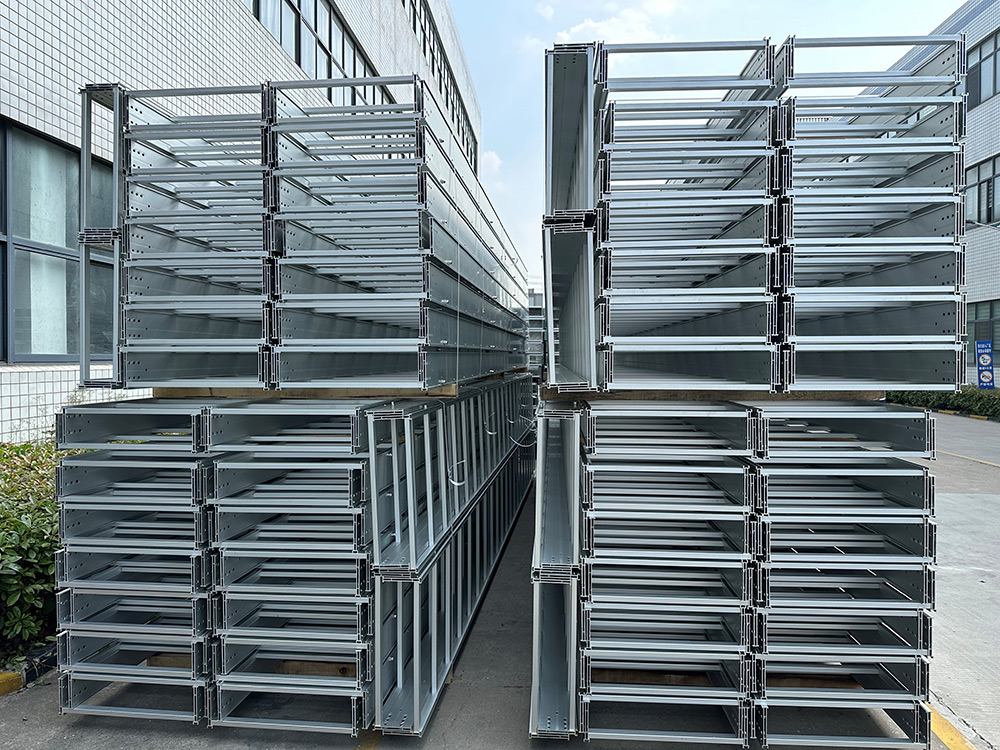Cable Tray Laying
1. The general layout of the cable tray should be the shortest distance, economical and reasonable, safe operation, and should meet the requirements of construction installation, maintenance and cable laying.
2. The cable tray should have sufficient rigidity and strength to provide reliable support for the cable.
3. After the cable is laid, the deflection of the cable tray should not be greater than 1/200 of the span of the cable tray. When the span of the cable tray is >6000mm, its deflection should not be greater than 1/150 of the span of the cable tray.
4. The cable tray should be installed on buildings and structures (such as walls, columns, beams, floor slabs, etc.) as much as possible, and work closely with civil engineering professionals.
5. When the cable tray is installed with the process pipe rack, the cable tray should be arranged on one side of the pipe rack.
6. When the cable tray is installed in parallel with various pipelines, the net distance should meet the following requirements:
6.1 The cable tray should not be less than 400mm when it is installed in parallel with general process pipelines (such as compressed air pipelines, etc.). 6.2 When the cable tray is installed parallel to the corrosive liquid pipeline, it should not be less than 500mm.
6.3 The cable tray should not be installed parallel to the pipeline transporting corrosive liquid or above the pipeline transporting corrosive gas. When it cannot be avoided, it should not be less than 500mm. And anti-corrosion partitions should be used to separate them.
6.4 The cable tray is installed parallel to the thermal pipeline. When the thermal pipeline has an insulation layer, it should not be less than 500mm, and when it does not have an insulation layer, it should not be less than 1000mm.
6.5 The cable tray should not be installed parallel to the thermal pipeline. When it cannot be avoided to install it parallel to the thermal pipeline, it should not be less than 1000mm, and effective insulation measures should be taken in between.
7. When the cable tray crosses various pipelines, the net distance should meet the following requirements:
7.1 When the cable tray crosses the general process pipeline, it should not be less than 300mm.
7.2 When the cable tray crosses the bottom of the corrosive liquid pipeline or the top of the corrosive gas pipeline, it should be no less than 500mm, and the cable tray should be protected by an anti-corrosion cover at the intersection, and the length of the cover should be no less than d+2000mm (d is the outer diameter of the pipeline).
7.3 When the cable tray crosses the thermal pipeline, if the thermal pipeline has an insulation layer, it should be no less than 500mm, and if it has no insulation layer, it should be no less than 1000mm, and the cable tray should be protected by an insulation board (such as asbestos board) at the intersection, and the length of the insulation board should be no less than d+2000mm. (d is the outer diameter of the thermal pipeline insulation layer)
8. When the cable tray is installed through the wall, a sealing device should be used according to the environmental conditions:
8.1 When the cable tray passes through the wall from the normal environment to the fireproof and explosion-proof environment, a corresponding sealing device should be installed on the wall.
8.2 When the cable tray passes through the wall from indoors to outdoors, rain protection measures should be taken on the outside of the wall.
8.3 When the cable tray is installed from indoors through the wall to a higher place outdoors, the cable tray should be tilted downward and extended for an appropriate distance before being erected upward to prevent rainwater from flowing into the room along the cable tray.
8.4 When the cable tray passes the expansion and settlement joint, the cable tray should be disconnected, and the disconnection distance should be about 100mm.
9. When two sets of cable trays are installed on the same beam, the net distance between the two sets of cable trays should not be less than 50mm.
10. When the cable tray for laying 10kV and above cables is installed in multiple layers, the interlayer spacing is generally not less than 300mm.
2. Meet the basic elements
When arranging the tray, it is necessary to make a comprehensive comparison based on the three basic factors of operability, economic rationality, and technical feasibility, otherwise it is impossible to determine the best solution. At the same time, the Henan Cable Tray Factory reminds that it is also necessary to fully meet the requirements of laying cables, construction and installation, and convenient maintenance.
3. Laying distance
Henan Cable Tray Factory reminds that when the cable tray is laid horizontally, the height from the ground cannot be less than 2.5 meters. If it is laid vertically, a metal cover plate needs to be installed for protection at a position below 1.8 meters from the ground. However, if the cable tray is laid in a dedicated electrical room, there is no need to install a protective cover plate. In addition, Henan Cable Tray Factory reminds that if the cable tray needs to be laid horizontally on the man-and-horse path or the equipment mezzanine, and it is still below two and a half meters, some grounding protection measures should also be taken
4. Corrosion resistance
If the cable trough, cable tray and support bracket are used in a corrosive environment, Henan Cable Tray Factory introduces that it is necessary to use a cable tray that has been treated with anti-corrosion or made of corrosion-resistant rigid materials, and the corrosion resistance must meet the standard. Shandong Bolt Electrical Equipment Co., Ltd. recommends choosing a cable tray made of aluminum alloy, which has better corrosion resistance.




